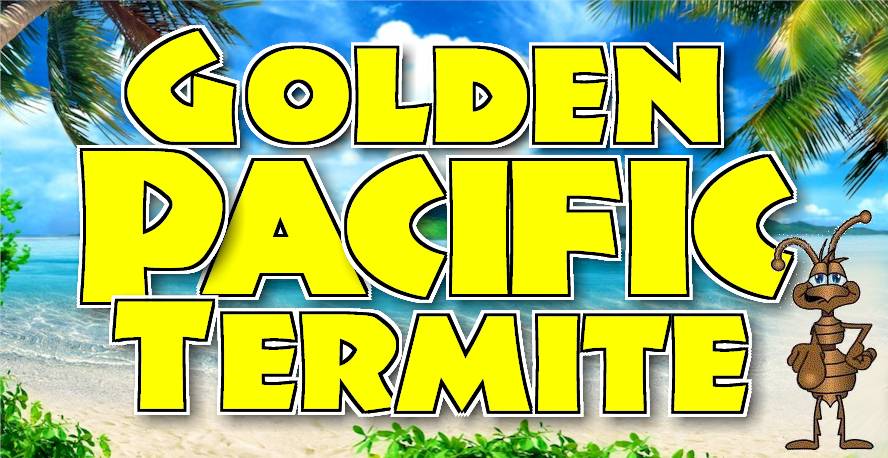

![]()
Termite Species
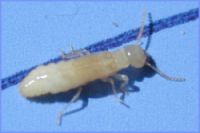 Termites
have a 200 million year evolutionary history closely related to
cockroaches. They can be found throughout Southern California.
Termites forage for food over a large area (approximately 100 metres)
in search of timber and operate and live in a central nest or
colony. The worker termites partially digest the timber before
returning to the nest to feed the colony. This can cause
considerable damage to our homes and bank accounts, as many Southern
Californian's will attest, and can happen in a matter of months. Termites
have a 200 million year evolutionary history closely related to
cockroaches. They can be found throughout Southern California.
Termites forage for food over a large area (approximately 100 metres)
in search of timber and operate and live in a central nest or
colony. The worker termites partially digest the timber before
returning to the nest to feed the colony. This can cause
considerable damage to our homes and bank accounts, as many Southern
Californian's will attest, and can happen in a matter of months.
Termite Species:
The Giant Termite (Mastotermes darwinensis) has the greatest
potential for destruction. However, it is limited to the tropical
areas of northern Southern California. It attacks any wood in
contact with the ground including shrubs and trees, as well as
paper, leather, clothing and other materials. It is a large-bodied
primitive species that usually forms small colonies and has no true
worker caste.
|
| Winged Reproductives or Alates are the future kings and queens of New Nests. Alates disperse in large numbers from mature colonies, usually in warm weather. Only a small percentage are successful in establishing new colonies. |
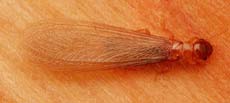 |
| Soldiers are sterile
males and females. Their main function is to protect the colony.
Soldiers cannot feed themselves and are dependent on the workers for
their nutrition. Workers are the sterile males and females that feed the colony, rear young and enlarge the nest. They are the only caste that can chew and digest the cellulose in wood. |
|
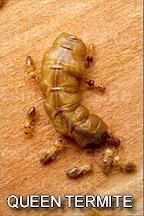 Alates AlatesOn a warm, humid evening, large numbers of winged male and female termites, the "alates" or "primary reproductives", are released by the colony. A small number survive the flight, drop their two pairs of distinctive, equal sized wings, pair off, mate and, if they can, find a suitable locations and start a new colony. Queen As the other castes take over the running of the colony the young queen of most species becomes "physogastric". Her abdomen distends to many times its original size and she becomes and egg laying machine, laying up to 1000 eggs a day. She is confined to her royal chamber, tended and fed by the workers and regularly fertilised by the king. Nursery The eggs are removed from the royal chamber and transferred to a nursery by the workers. Here the broo (the eggs and nymphs) develops into the other castes that the colony requires for development and survival; workers, soldiers and primary or secondary reproductives. Soldiers and Workers Soldiers and workers are blind and sterile termites. The workers carry out the work of the colony and are responsible for gathering the food the colony needs. In most species, the heads of the soldiers are uniquely armoured and equipped to allow them to defend the colony against attack, notably from ants. |
 |
The difference between Termites and Ants Is it an ant (left) or a termite (right)? It is not uncommon for people to think of termites as members of the ant family. However, ants, of the Hymenoptera order, and termites, of the Isoptera order, are in fact unrelated. Visually in a picture of a termite, you can distinguish between them, ants have a slender waist. The waists of termites are about the same thickness as the rest of the body. |
 |
|
Termite Nests |
|
| Feeding Nourishment poses no problem for termites, these insects are one of only a few species able to digest the Cellulose contained in deadwood (such as timber). |
|
| Termites eat (hollow out) channels, called Galleries, inside of wood leaving the outside intact but, often, paper-thin. |
 |
|
To survive subterranean
termites need contact with soil & moisture. They only need a tiny
amount of water but they must have it. |
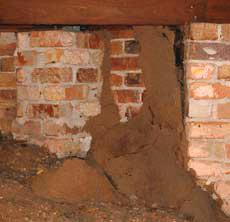 |

Home - Cities We Serve - Customer Testimonials - Citrus Based Insecticides - Photo Gallery - Queen Termites - Termite Species
Copyright © 2012 GoldenPacificTermite.com All rights reserved. For questions or comments about this site please contact BarryBraisher@yahoo.com
